

 The Accurate Reloading Forums
The Accurate Reloading Forums  THE ACCURATE RELOADING.COM FORUMS
THE ACCURATE RELOADING.COM FORUMS  Hunting
Hunting  African Big Game Hunting
African Big Game Hunting  Inbound – a Buffalo Hunting Story
Inbound – a Buffalo Hunting StoryGo  | New  | Find  | Notify  | Tools  | Reply  |  |
| One of Us |
Inbound – a Buffalo Hunting Story Kevin Thomas© Tracking a solitary buffalo dagha bull or even a group of them is probably the purist form of buffalo hunting a hunter can experience. During May in Zimbabwe, the large buffalo herds have a fair amount of bulls in attendance, usually soft-boss buffalo from four to six years old. Peripheral to the herd, and hugging the outer edges there are often old dagha bulls who satellite the herd, and as the dry months wear on, so too, do they invariably move off and take up their solitary, or small bachelor group existence. When I’d first met Peter Tague in the US, during the planning stages of his pending Zimbabwe safari, booked through Glenn Baker, he’d specifically requested that we try and find a good buffalo trophy bull – and although inches didn’t come into play, the emphasis was on ‘good’. Peter had also said that he wanted to have a classical African safari experience, and a fun hunt, the kind of client I like to guide. He was due into Dyer’s Camp with close friends of his from the US, Jerry and Cheri Poole, and their son Dillon. My colleague, friend, and fellow PH Lance Nesbitt would be guiding the Poole’s on the BVC (Bubye Valley Conservancy) for the second consecutive season. On our first morning, and after a shot with Pete’s rifle at the zeroing range, we checked waterholes across the hunting block, and although we also crossed sign of some big buffalo herds, we chose to ignore it; our quest was to try and find some old dagha bulls. Earlier on in the morning, and with the sun still balancing on the eastern horizon, we’d been seen off by a grumpy old elephant bull. He’d been lurking behind a big mopane tree on the side of the track, and as we’d approached him it’d gone through my mind that his overall body language most certainly didn’t project an air of relaxation. Whilst we slowly drove closer, he suddenly came round the tree, deadly quiet, lowered himself on his front legs, tucked his trunk up into his chest, drew his ears into the side of his neck, and charged in a very determined manner. Whacking the stick-shift into reverse, I cussed having our guns racked on the carriers blocking my rearward view through the cab’s rear window, as we hastily tried to exit the area in reverse. The scrub mopane either side of the track was so thick, a three-point turn was out of the question. The elephant meantime, continued to chase us for a good 100m before swinging off to the right. Stopping, we allowed Lingani my skinner to hastily climb onto the roof-rack and look if the elephant was still there – it was – and once more waiting silently. We chose to use an alternate route. Not two hours later, and as we drove down into a steep-sided sandy streambed a huge black mamba slithered across the track just behind the Cruiser, causing shouts of alarm amongst my trackers, one of whom explained that it was as thick as his forearm, and stretched right across the track. Fortunately, it’d disappeared down a termite mound ventilation shaft. Peter and I joked about how our first day had started, and wondered how it would end! At about 10hr00 we reached the fourth waterhole in the area we were hunting, and after I’d stopped the vehicle, the trackers did their usual 360º scout around, close in and further out from the waterhole, although much of the spoor from animals watering earlier, had already been obliterated by large flocks of guinea fowl, and by frequent visitations to the water by the ubiquitous blue wildebeest herds, that come and go all day on the BVC. Pete and I had waited by the vehicle so as not to get in the way while the trackers did their job – a job requiring a high level of experience, skill, and sharp eyesight if ever. Suddenly, Barnabas whistled, and signalled to me that he had fresh spoor. After we’d joined him and his colleagues, he’d pointed out the huge hoof prints of a single dagha bull. It had moved off to our east, and the indications were that it had watered during the night, probably shortly after dark. The fact that it was a solitary bull, placed me in a bit of a quandary, because a hunter can devote five hours of tracking a buffalo, only to then close with a ‘scrumcap’ – an old bull who has broken or worn horns, with little left aside from the bosses. However, from a personal perspective I class these old ‘scrumcaps’ as true trophies. For the most, they are battle scarred from numerous encounters with lion and hyena, or from fighting amongst themselves, and they may carry old wounds, snares, and a variety of other battle honours. Generally, they’re rheumy eyed, arthritic, and worm-infested, with little humour and absolutely no will to negotiate with an adversary. If they were humans, they’d be true warriors with a chest full of valour medals. Thus, I salute them, and also love to hunt them. An old ‘scrumcap’ as a European shield mount, and hung between two good trophy buffalo shoulder mounts is a fine sight. Given that it was our first day, and after we’d discussed the advantages and disadvantages of tracking a solitary bull, we’d decided to track the bull and see what materialised. Thereafter, it took about four hours before we closed with him, however, during that period we soon developed a healthy respect for our quarry. He never rested for long, and when he did, it was in the densest thicket he could find, and whilst on the move he constantly zigzagged, often turning round and facing his back trail. The BVC is a 1 million acre hunting block with well managed and healthy wildlife populations, including lion, and it is the lion population more than anything that keep the buffalo herds and dagha bulls in an almost 100% alert mode – 24/7. The first glimpse of our quarry was fleeting to say the least, we were moving exceedingly quietly in dense bush, knowing we were close; his wild bovine smell strong in our nostrils. Then we came upon a recent resting place, a damp urine patch still with receding foam on it, insect and mucus covered fresh dung, and in the loose soil the clear imprint of a recumbent buffalo’s body. Immediately adjacent to the resting place, there was a stand of well-leafed scrub mopane, and we couldn’t see through it – it was a solid wall of grey/green saplings. Unbeknown to us, the buffalo was behind this scrub, he’d moved out of the sun and into the shade, probably mere minutes before our arrival. The tension on the trackers’ faces was easily discernable; they knew he was close. Suddenly the buffalo let us know just how close, when from behind the scrub there was a harsh snort and the loud clatter of stones, and galloping hooves, as he fled. We got a fleeting glimpse of his horns from the rear; they were heavy and wide, with deep curves, certainly no ordinary old dagha bull. Because of the quality of the horns, coupled to his extreme alertness, we opted to mark the spot and recover to camp for lunch, rather than push him too hard. During the afternoon, we’d return and then try again. Pete was carrying his custom built .375 H&H which was wearing a Trijicon 1.5 x 10 power variable scope. His bullets were Federal Premium Safari Cape-Shok 300gr Sledgehammer solids, and 300gr soft point Bear Claw trophy bonded partitions, both designs well proven in the hunting of dangerous game in Africa. For my part, I was carrying my .458 Lott which I’d loaded with North Fork’s 500gr FPS (Flat Point Solids), in front of 75grs of S335, which through the chronograph were giving me 2150fps which I was happy with. By 1430hrs we were back where we’d first disturbed the buffalo, and again took up the spoor. It was a hot sultry afternoon, and he hadn’t run far, his huge front hooves digging into and scuffing up the dirt, before slowing to a steady walk which took us through dense riverine bush, high grass, and thorn thickets. Eventually at about 17hr00 and as we approached a dry streambed, still on spoor, we again heard the signature sound of a fleeing buffalo galloping across stony shale. He’d typically approached the river, and then doubled back downwind, parallel to his inbound spoor, but to a position from where he could watch his back trail. He’d then bedded down and we’d unwittingly walked right past him without seeing him, and then once he’d scented us, he’d leapt up and fled. My belief was that he was still trying to avoid lion, and that we had just become an incidental hindrance. That evening around the campfire, we determined that we would make every effort to once more find this particular bull, and early next morning we’d departed camp by 06hr00, the headlights probing the pre-dawn dark as we again went out to try and relocate the wary dagha bull’s spoor. As the sun rose, so too did the dew covered cobwebs strewn across the scrub begin to sparkle like God’s jewellery. Arriving at another waterhole not too far from where we’d first picked his tracks; we again located them and commenced our third follow-up. Not long after he’d departed the water, a second bull, although with smaller hoof-prints linked up with him. They’d then meandered through the thick stuff together, periodically grazing, or standing watching and listening, before ultimately splitting up and going their separate buffalo ways. We stayed with the old bull’s spoor, and eventually, after some of the most brilliant tracking I’ve ever seen, we again closed with him. This time however, and despite our extreme caution and quiet approach, we only heard him snort loudly from close by, and then go crashing away. By that stage, visibility was down to about 2m with the green leaf canopy meeting the grass tops. Once again, he’d cleverly check mated us by using the wind. Calling the hunt off, we recovered back to the rig and then returned to camp, ultimately spending the afternoon hunting plains game. Next morning, I decided not to pursue the buffalo again, so we focused on a zebra and Pete shot a nice stallion, Jerry too, shot his buffalo, and in the afternoon Pete shot a nice old impala. That evening however, our campfire conversation was all about the big dagha bull that had thus far eluded us, and Pete and I became more determined than ever to find him – not an easy task given the size of the hunting area and the high buffalo densities. Prior to dinner, we decided that our quest of the next day would be devoted to trying to find him again. He’d had a full day of not being disturbed by us, and we felt he’d have settled down again. On Sunday 05 May, we were once more up at an early hour, and just before we departed I’d asked the trackers if they thought we’d find the same bull again, emphasising just how much Pete and I would like to find it. With the typical philosophy of a tribal tracker, Barnabas replied, “If today is his day to die we will find him”. Our first two waterhole checks came up with nothing, and after a bit of confusion over spoor at the third, the trackers eventually managed to confirm the elusive bull’s tracks and we again took them up. Once more we followed a familiar pattern, that of a zigzagging trail, with the bull at times leading us back over his and our spoor from our previous attempts at finding him. The bush was incredibly thick with visibility in many places down to about 5m or less. He often too, followed the course of a narrow meandering sandy streambed. We found a number of places too, where he’d pummelled saplings with his horn bosses, shredding the bark and scattering leaves, or where he’d rubbed mud off against branches after wallowing. Red-billed oxpeckers periodically gave their alarm chirr- chirr- chirr whilst winging their way up into the tree tops from inside the thick stuff. Once, and from on our knees we tensely watched a black rhino, before backing out. When the oxpeckers had initially flown up into the uppermost branches of the tree, we’d thought the rhino had been our buffalo quarry and it was only when we’d crawled in close and seen the distinct sway-back silhouette of the rhino that we’d realised our mistake. Fortunately as we’d backed out on hands and knees, the wind held steady and there was no mad scramble for the safety of a tree. Eventually the buffalo’s dung became warmer, and his urine patches remained damp and foam coated, although he continued to wander in huge circles we could sense he was close, so we slowed our pace right down, frequently stopping to watch and listen, and with the ash bag wind indicator in Barnabas’s hand flicking constantly. Again too, the wild bovine scent of buffalo hung heavy in the air. Suddenly, a troop of baboons high up in the riverine canopy above us detected our presence and raised the alarm. We froze and then sank to our haunches, waiting – and hoping the baboons would move off. Frustratingly though, they remained above us and continued hurling verbal abuse our way. Deciding it was pointless waiting any longer, we cautiously pressed forward, and had hardly gone 80m when as we came up onto some high ground from inside the riverine, the trackers dropped and silently indicated to our front. Hastily opening the sticks, I caught sight of the buffalo’s head facing us, but staring at something much higher than our level – the raucous baboons, plus we had the advantage of the sun directly at our backs. Only his head was clearly visible, and a part of his left shoulder immediately beneath the deep curve of his horn. He was broadside on and Pete wasted no time, as his .375 H&H shot reverberated through the brush, and the 300gr Federal Premium Cape-Shok Sledgehammer Solid went true, the buffalo lurched forward, nearly lost his footing, recovered, and then galloped round and past us. Although we both got in a raking shot, a thicket screened him from us until the last few seconds, and then he was gone and all went quiet. As he disappeared, so too, did a second bull which we hadn’t been aware of, bust out of the brush and take off, they’d obviously both linked up again where he’d decided to rest. We sat listening and waiting, Pete was sure of his shot and I too, due to the buffalo’s reaction felt that it’d been well-placed. Normally if a buffalo takes off after being shot, one waits for at least 30 minutes, or for a minimum of 20 minutes before continuing the follow-up. This is to allow for the animal to hopefully die, or at least lie down, stiffen up, get sick, or bleed out. However, buffalo have incredible adrenalin reserves and don’t always play the game. More often than not, a wounded buffalo makes every attempt to put as much distance between it and the hunter as it can, and continues to do this each time it is disturbed. However, there does come a time when he will make a stand, and particularly so if badly wounded and in pain. In our case, Pete’s shot had been well-placed and mortal, the buffalo didn’t go far because he was dying and sick, important too though, was the fact that he was still on his feet, and me and my trackers impatience was nearly our undoing. Trackers who’ve been hunting dangerous game for a long time sometimes become blasé, and they place too much faith in their PH’s shooting skills. Barnabas hates waiting, and often argues that a buffalo might only be lightly wounded and running. On this particular occasion I went with his thinking, and after not even waiting a full 15 minutes we moved forward and found blood where the buffalo had galloped past the thicket, and so we cautiously took up the trail. We didn’t go very far, and with Pete at my left shoulder, we’d just crossed the narrow streambed and were about 10m on the other side of it, when the trackers suddenly crouched. Pete and I quickly moved forward and dropped onto our knees – the buffalo was about 35m to our front inside an acacia thicket – all we could see though, was his legs, from the knees down, and nothing else. He was restless and shuffling round on his feet, moved to and fro through 180º but we couldn’t even see his body at all. Suddenly, he crashed off through the thicket, away from us, and again, all went quiet – a tense, gut churning quiet. Not wasting too much time, we pressed forward; ultra alert to every sound and movement to our front and flanks, the trackers eyes ever watchful for more sign than just ground spoor. The brush was dense, most of it still in leaf although fortunately it was still made up of acacia thickets with only scatterings of scrub mopane. My concern and that of the trackers too, was that the wounded bull would make it to the dense scrub mopane that covered vast areas further on in the direction we were headed. Tracking a wounded buffalo in scrub mopane which is still heavily in leaf is invariably a tension fraught nightmare experience, and if possible, we wanted to avoid such a scenario. As fate would have it though, we hadn’t gone more than another 40m when all of a sudden there was a loud and violent attention getting Baugh to our front – it was a throaty grunt, saturated with anger, pain, and frustration. All I had time to shout was, “He’s coming!” Because headed towards us with the speed of a freight train and noisily flattening the scrub to our front was the inbound buffalo – a huge black mass, his head capped with wide horns, and heavy bosses. Luckily as Pete and I threw lead the buffalo’s way, Sgt Magotchie the legendary BVC game scout and tracker, broke to the left of us and the buffalo immediately locked onto his fleeing form. This allowed us to get in some vital side shots, before the buffalo suddenly changed direction and ran straight across our front at about 15m, once more allowing us time for some well-placed shots. Dying, although still on his feet, he then took stand inside another thicket where Pete was able to get in a well-placed coup de grace. After cautiously approaching the noble beast’s stilled form we stood silently admiring him, his bosses, teak hard and heavy, and his horns deeply curled and wide, his neck and facial skin deeply scarred from passed battles for survival against lion. He was a true warrior and survivor, and a magnificent trophy, thus, and as we came off our adrenalin high, we relived the excitement, the trackers all talking at once, Leonard exclaiming loudly that he’d climbed a tree in the face of the charge. While we stood alongside the buffalo’s form, Pete and I shook hands to bring closure to this fantastic hunt, and I congratulated him for standing at my shoulder and doing what was needed, like a veteran buffalo hunter. 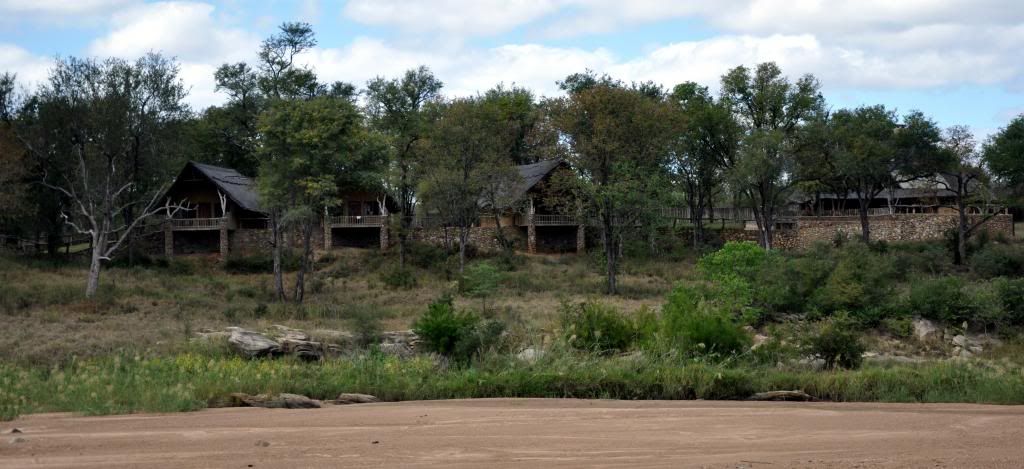 On Zimbabwe’s Bubye Valley Conservancy we hunted from the well appointed Dyer’s Camp situated on the Bubye River. 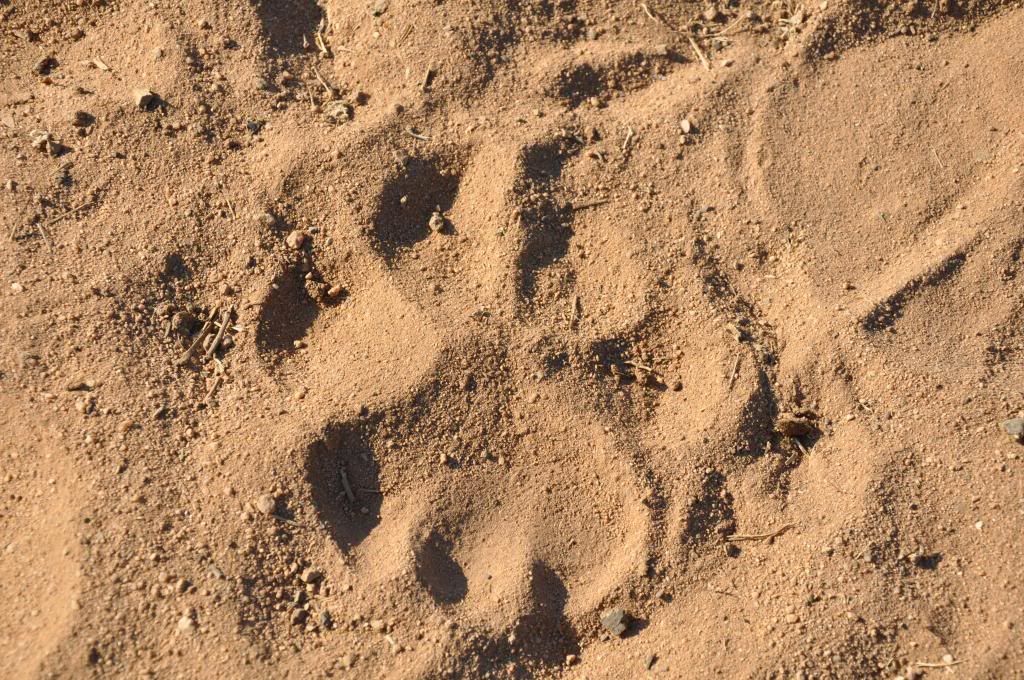 Lion are well represented on the Bubye Valley Conservancy and every time we hunted buffalo we encountered lion tracks. 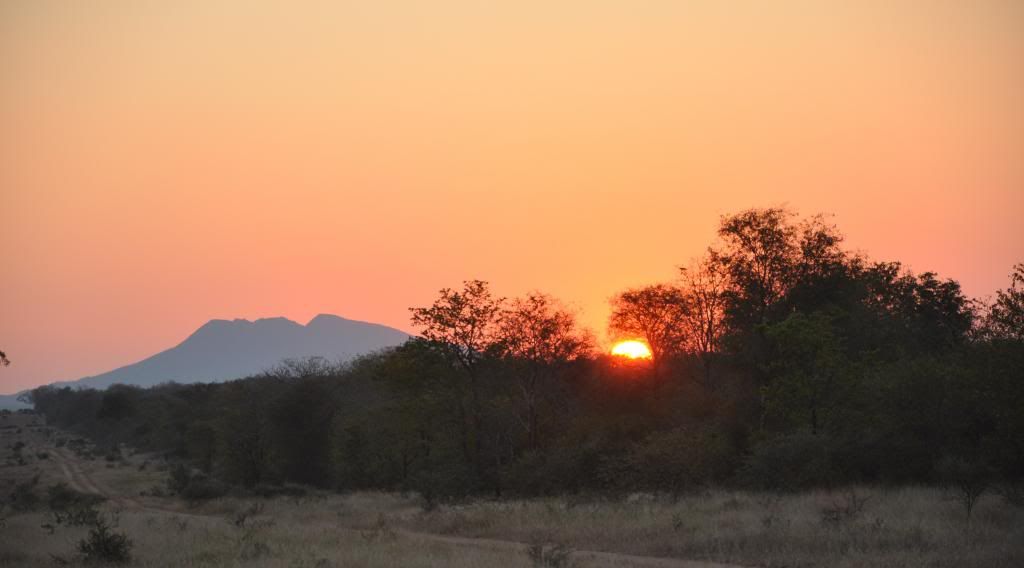 It is always pleasant returning to camp at sunset, with Towla Mountain as a backdrop. 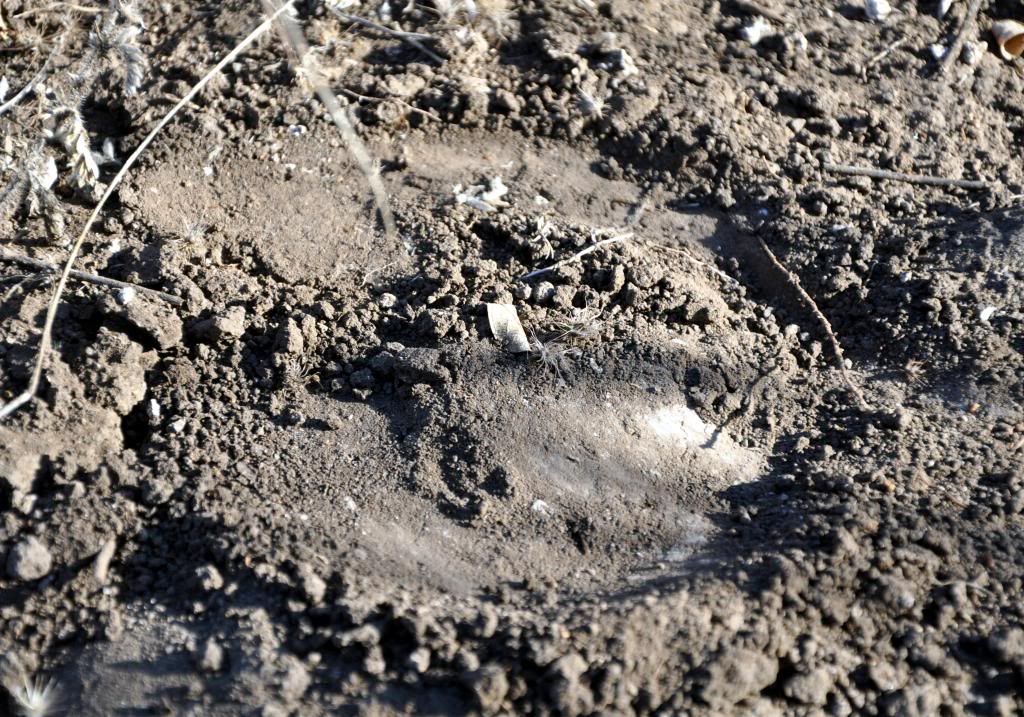 The dagha bull’s tracks were exceedingly fresh. 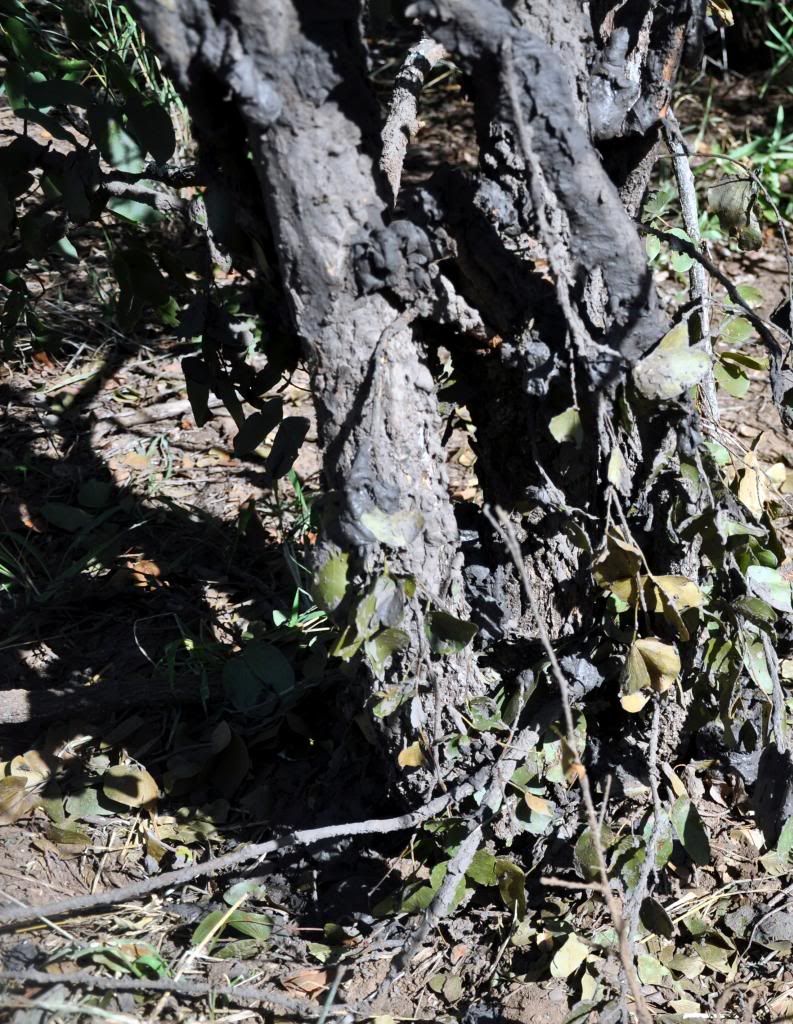 There was ample sign of where he’d rubbed mud off against mopane saplings as he moved away from the waterhole. 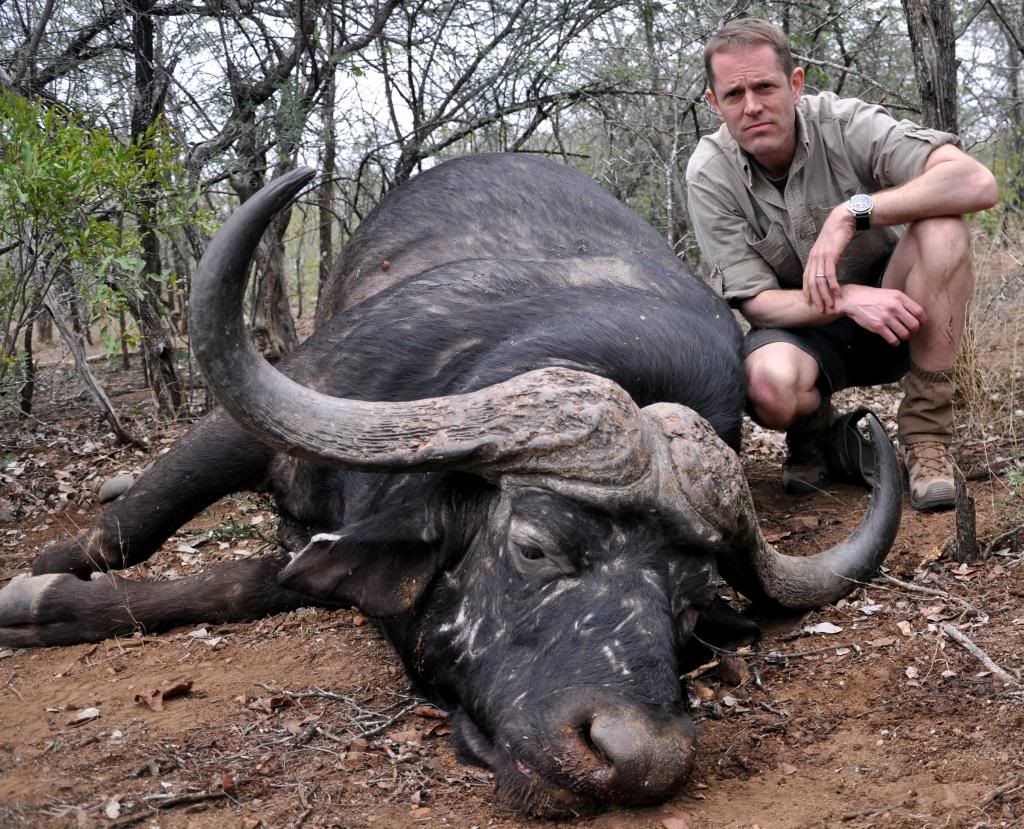 A proud Peter Tague poses with his magnificent 43” buffalo trophy after an exciting end to the hunt. 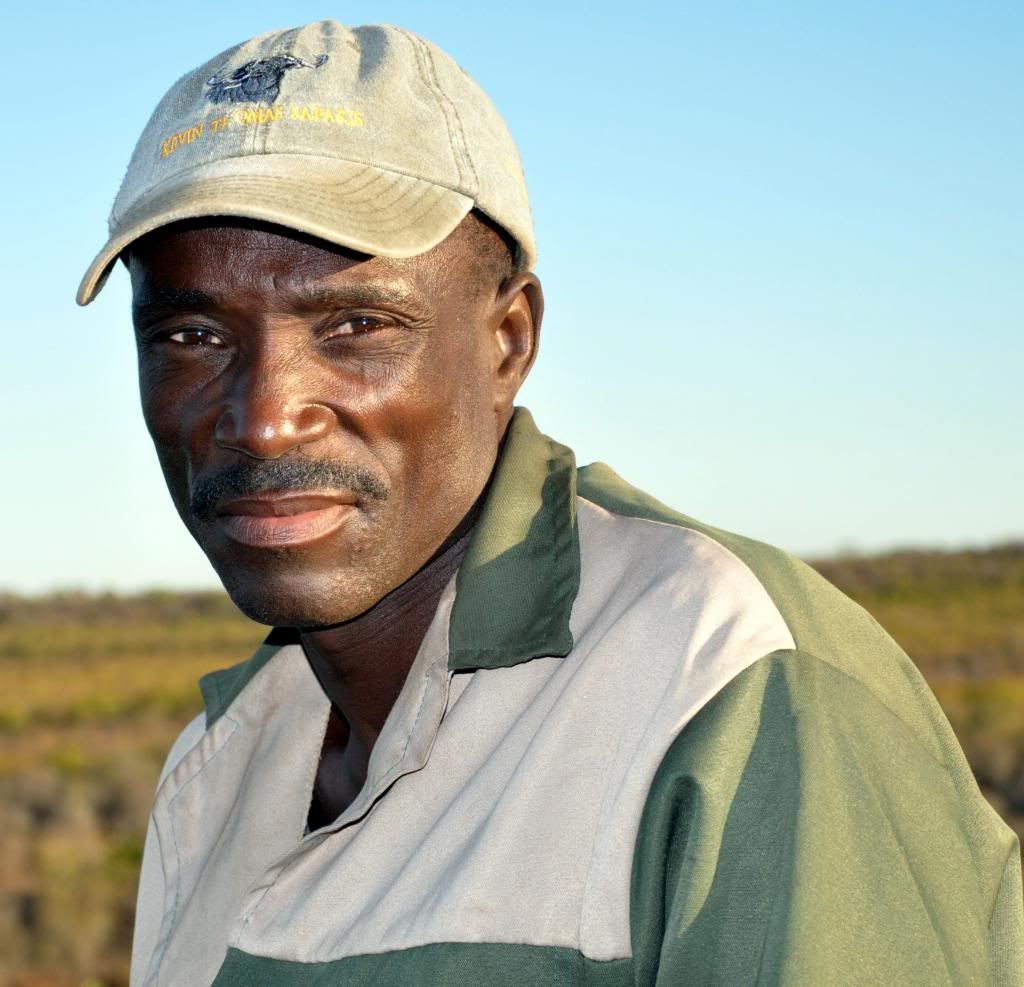 My indomitable, loyal, and highly skilled tracker Barnabas Nyati (his surname translates to buffalo!). 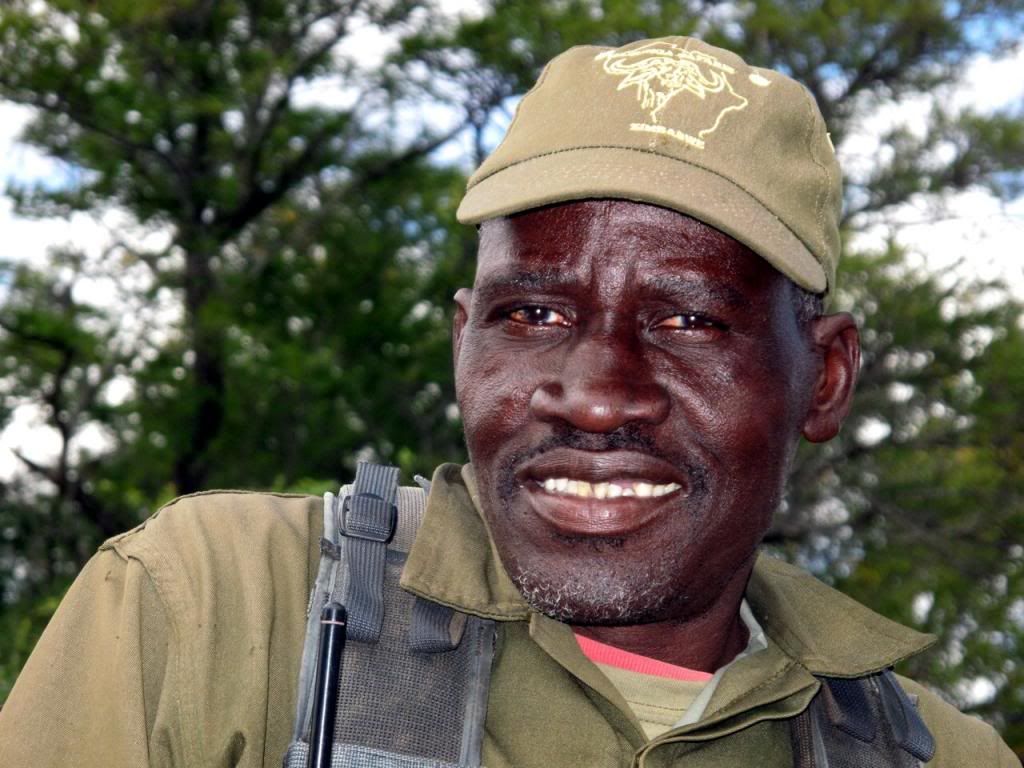 The BVC’s legendary game scout Sgt Magotshi, a true backwoodsman if ever, and Chief Conservator Blondie Leatham’s right hand man. Magotshi now 59 years old was born on the BVC and has spent his entire life there. I have had the honour of hunting with him a number of times over the years. Kevin Thomas Safaris Zimbabwe - Eastern Cape E-mail: ktsenquiries@mweb.co.za Website: www.ktsafaris.co.za | ||
|
| one of us |
Great hunt and a great story. Thanks for sharing. Ski+3 | |||
|
| one of us |
You ought to write a book Kevin... wait a minute, you have! Well written and you made me "see" the hunt as it unfolded. One of the reasons I love to hunt buffalo is the tricks on the tracks the old guys pull. Thanks again for sharing. On the plains of hesitation lie the bleached bones of ten thousand, who on the dawn of victory lay down their weary heads resting, and there resting, died. If you can talk with crowds and keep your virtue, Or walk with Kings - nor lose the common touch... Yours is the Earth and everything that's in it, And - which is more - you'll be a Man, my son! - Rudyard Kipling Life grows grim without senseless indulgence. | |||
|
| One of Us |
Great story telling and yes to the book " Until the day breaks and the nights shadows flee away " Big ivory for my pillow and 2.5% of Neanderthal DNA flowing thru my veins. When I'm ready to go, pack a bag of gunpowder up my ass and strike a fire to my pecker, until I squeal like a boar. Yours truly , Milan The Boarkiller - World according to Milan PS I have big boar on my floor...but it ain't dead, just scared to move... Man should be happy and in good humor until the day he dies... Only fools hope to live forever “ Hávamál” | |||
|
| One of Us |
Great buff & a well-told story. I had the extreme pleasure of hunting with Sgt Magotshi in the BVC (Chamalaya Camp in 2010). His tracking skills are super natural. The fact that he acted as a human decoy on an enraged buffalo speaks volumes about him. | |||
|
| One of Us |
Enjoyed the read...FANTASTIC sir | |||
|
| Powered by Social Strata |
| Please Wait. Your request is being processed... |
|
 The Accurate Reloading Forums
The Accurate Reloading Forums  THE ACCURATE RELOADING.COM FORUMS
THE ACCURATE RELOADING.COM FORUMS  Hunting
Hunting  African Big Game Hunting
African Big Game Hunting  Inbound – a Buffalo Hunting Story
Inbound – a Buffalo Hunting Story

Visit our on-line store for AR Memorabilia

